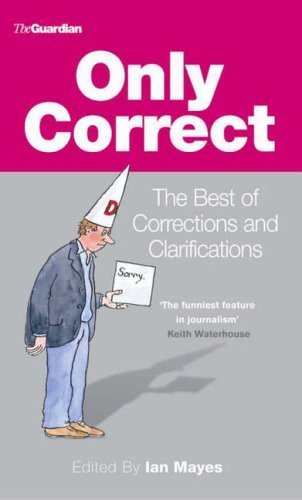How To Write Effective Corrections And Clarifications

Table of Contents
Understanding the Need for Corrections and Clarifications
Timely and accurate corrections are essential for several reasons. Ignoring errors or providing unclear clarifications can severely damage your reputation and erode trust with clients, colleagues, and stakeholders. Delayed responses only exacerbate the problem, leading to further misunderstandings and potentially escalating the issue.
Various situations necessitate corrections and clarifications. These include:
- Factual errors: Incorrect data, figures, or statements in reports, presentations, or publications.
- Misinterpretations: When information is understood differently than intended by the sender.
- Misleading information: Statements or data that, while not outright false, create a misleading impression.
- Omissions: Important information left out of a communication.
Addressing these issues promptly is critical for:
- Maintaining a professional image: Showing your commitment to accuracy and responsibility.
- Preventing misunderstandings: Avoiding further confusion and potential conflict.
- Building trust with stakeholders: Demonstrating your integrity and reliability.
- Addressing inaccuracies promptly: Minimizing the negative impact of errors.
Planning Your Correction or Clarification
Before writing your correction or clarification statement, a structured approach is essential. This ensures a clear, concise, and effective response. Begin by:
- Identifying the specific error or misunderstanding: Pinpoint the exact inaccuracy and its context.
- Determining the appropriate audience: Who needs to receive the correction? Is it an individual, a group, or a wider public?
- Choosing the communication channel: Will an email suffice, or is a formal letter or public statement required?
Consider these key aspects of your planning:
- Identify the source of the error: This helps prevent future mistakes.
- Determine the scope of the correction: How widespread is the error? How many people need to be informed?
- Choose the best communication method (email, letter, public statement): Select the most appropriate method for your audience and the severity of the error.
- Consider the audience's level of understanding: Tailor your language and level of detail accordingly.
Writing Effective Corrections and Clarifications
Clarity, conciseness, and professionalism are key when writing corrections and clarifications. Use plain language, avoiding jargon or technical terms that your audience may not understand. Acknowledge the error directly, without making excuses. Provide accurate and complete information to replace the inaccurate information.
Here's how to structure your correction:
- Use a clear and concise subject line: For example, "Correction: Project X Timeline" or "Clarification Regarding Policy Y".
- Start with an apology if appropriate: A sincere apology can go a long way in demonstrating accountability.
- Clearly state the error and provide the correct information: Be explicit about what was wrong and what is correct.
- Maintain a professional and respectful tone: Avoid defensiveness or blaming others.
- Proofread carefully before sending: Errors in your correction undermine your credibility.
Choosing the Right Communication Channel
The choice of communication channel depends on several factors, including the audience, the severity of the error, and the need for a public record.
- Email: Suitable for internal corrections or for communicating with individuals.
- Formal letter: Appropriate for significant errors or when communicating with external stakeholders who require a formal record.
- Public statement: Necessary for widespread misinformation or when a public correction is needed.
- Website update: Ideal for correcting information on a company website or online platform.
Review and Distribution
Before distributing your correction or clarification, thorough review is paramount. Involving a second person for review ensures accuracy and appropriate tone.
- Proofread for grammar, spelling, and punctuation errors.
- Ensure clarity and consistency of message.
- Seek feedback from a colleague or supervisor.
- Monitor responses and address any further queries. Tracking responses helps you gauge the effectiveness of your correction and address any lingering concerns.
Conclusion
Writing effective corrections and clarifications is vital for maintaining credibility and fostering trust. By following these steps—understanding the need, planning carefully, writing clearly, choosing the right channel, and reviewing thoroughly—you can ensure your corrections and clarifications are well-received and address the issue effectively. Master the art of writing effective corrections and clarifications to improve your communication skills and build stronger relationships. Implement these strategies today and elevate your professional communication!

Featured Posts
-
 Is Age Just A Number The Role Of Mindset And Health In Successful Aging
Apr 30, 2025
Is Age Just A Number The Role Of Mindset And Health In Successful Aging
Apr 30, 2025 -
 Eurovision 2025 Song Debut Remember Mondays Capital Breakfast Reveal
Apr 30, 2025
Eurovision 2025 Song Debut Remember Mondays Capital Breakfast Reveal
Apr 30, 2025 -
 Princetons Laptop Donation Boosting Education And Digital Literacy In Nj Correctional Facilities
Apr 30, 2025
Princetons Laptop Donation Boosting Education And Digital Literacy In Nj Correctional Facilities
Apr 30, 2025 -
 Louisvilles Shelter In Place Order A Reflection On Past Tragedy
Apr 30, 2025
Louisvilles Shelter In Place Order A Reflection On Past Tragedy
Apr 30, 2025 -
 Can Trumps Tariffs Replace Income Taxes 4 Key Complications
Apr 30, 2025
Can Trumps Tariffs Replace Income Taxes 4 Key Complications
Apr 30, 2025
Latest Posts
-
 Boulangerie Normande Cadeau Exceptionnel Pour Le Premier Bebe 2024
May 01, 2025
Boulangerie Normande Cadeau Exceptionnel Pour Le Premier Bebe 2024
May 01, 2025 -
 Premiere Naissance De L Annee Une Boulangerie Normande Offre Son Poids En Chocolat
May 01, 2025
Premiere Naissance De L Annee Une Boulangerie Normande Offre Son Poids En Chocolat
May 01, 2025 -
 Boulangerie Normande Un Cadeau Chocolate Pour Le Premier Bebe De L Annee
May 01, 2025
Boulangerie Normande Un Cadeau Chocolate Pour Le Premier Bebe De L Annee
May 01, 2025 -
 Cette Boulangerie Normande Offre Son Poids En Chocolat Au Premier Bebe De L Annee
May 01, 2025
Cette Boulangerie Normande Offre Son Poids En Chocolat Au Premier Bebe De L Annee
May 01, 2025 -
 Neispricana Prica Zdravkova Prva Ljubav I Inspiracija Za Pesmu Kad Sam Se Vratio
May 01, 2025
Neispricana Prica Zdravkova Prva Ljubav I Inspiracija Za Pesmu Kad Sam Se Vratio
May 01, 2025
